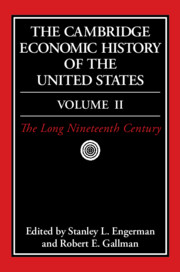Book contents
- Frontmatter
- 1 Economic Growth and Structural Change in the Long Nineteenth Century
- 2 The Economy of Canada in the Nineteenth Century
- 3 Inequality in the Nineteenth Century
- 4 The Population of the United States, 1790–1920
- 5 The Labor Force in the Nineteenth Century
- 6 The Farm, The Farmer, and The Market
- 7 Northern Agriculture and the Westward Movement
- 8 Slavery and its Consequences for the South in the Nineteenth Century
- 9 Technology and Industrialization, 1790–1914
- 10 Entrepreneurship, Business Organization, and Economic Concentration
- 11 Business Law and American Economic History
- 12 Experimental Federalism: the Economics of American Government, 1789–1914
- 13 Internal Transportation in the Nineteenth and Early Twentieth Centuries
- 14 Banking and Finance, 1789–1914
- 15 U.S. Foreign Trade and the Balance of Payments, 1800–1913
- 16 International Capital Movements, Domestic Capital Markets, and American Economic Growth, 1820–1914
- 17 The Social Implications of U.S. Economic Development
- Bibliographic Essays
- Index
- References
7 - Northern Agriculture and the Westward Movement
Published online by Cambridge University Press: 28 March 2008
- Frontmatter
- 1 Economic Growth and Structural Change in the Long Nineteenth Century
- 2 The Economy of Canada in the Nineteenth Century
- 3 Inequality in the Nineteenth Century
- 4 The Population of the United States, 1790–1920
- 5 The Labor Force in the Nineteenth Century
- 6 The Farm, The Farmer, and The Market
- 7 Northern Agriculture and the Westward Movement
- 8 Slavery and its Consequences for the South in the Nineteenth Century
- 9 Technology and Industrialization, 1790–1914
- 10 Entrepreneurship, Business Organization, and Economic Concentration
- 11 Business Law and American Economic History
- 12 Experimental Federalism: the Economics of American Government, 1789–1914
- 13 Internal Transportation in the Nineteenth and Early Twentieth Centuries
- 14 Banking and Finance, 1789–1914
- 15 U.S. Foreign Trade and the Balance of Payments, 1800–1913
- 16 International Capital Movements, Domestic Capital Markets, and American Economic Growth, 1820–1914
- 17 The Social Implications of U.S. Economic Development
- Bibliographic Essays
- Index
- References
Summary
INTRODUCTION
Thomas Jefferson envisioned the United States as an experiment in political democracy founded upon an economy of small farms. This essay examines the geographic expansion and economic development of agriculture during the nineteenth century across the northern region, where Jefferson hoped his vision would materialize most clearly. Central to realizing this goal was transferring land in the public domain into the hands of aspiring farm families. Our theme in this chapter is the heightening tension between the political vision of a nation inhabited by self-sufficient, landowning farmers and the economic reality of increasing agricultural commercialization, tenancy, wealth inequality, and industrialization.
The century opened with an agricultural-commercial economy in which farming played the central role. It closed, however, with agriculture as a relatively diminished sector encroached upon by a rapidly advancing industrial system and by corporate business. In between, farming evolved from a simple, traditional activity into a highly productive commercial enterprise that not only fed the domestic population but exported worldwide and supplied the raw materials that fueled American industrialization. The outcome, ironically, was an increasingly productive farm sector populated by increasingly discontented farmers. These individuals, who believed that the national economy was developing at their expense, ultimately sought governmental solutions when markets did not meet their personal expectations. Nevertheless, the structural transformation progressed, becoming a driving force behind the national population’s dramatically improving economic well-being over the nineteenth century.
- Type
- Chapter
- Information
- The Cambridge Economic History of the United States , pp. 285 - 328Publisher: Cambridge University PressPrint publication year: 2000
References
- 7
- Cited by



